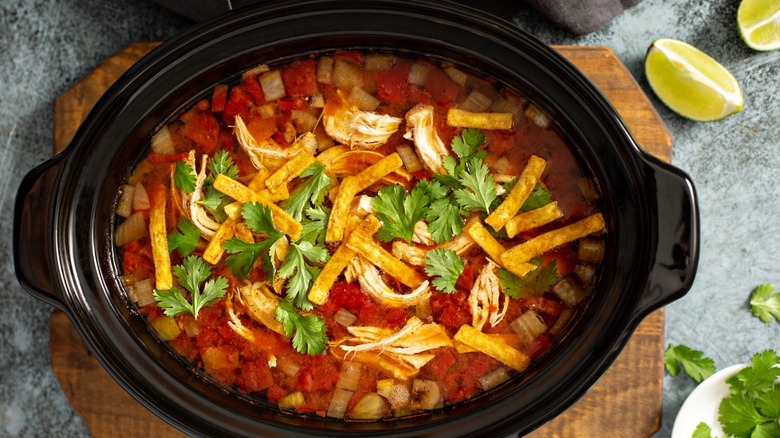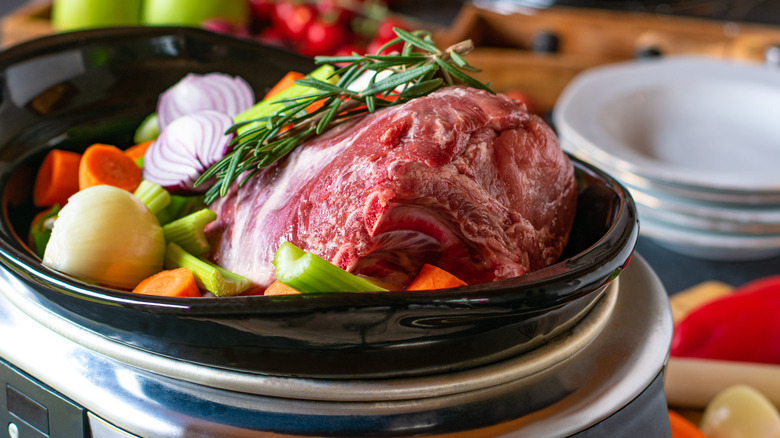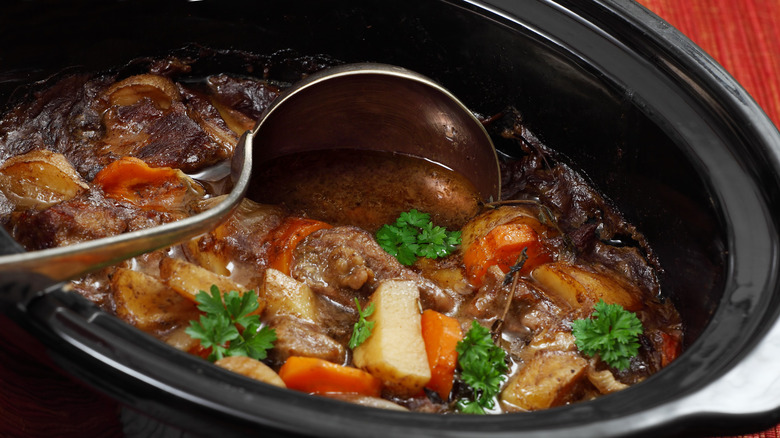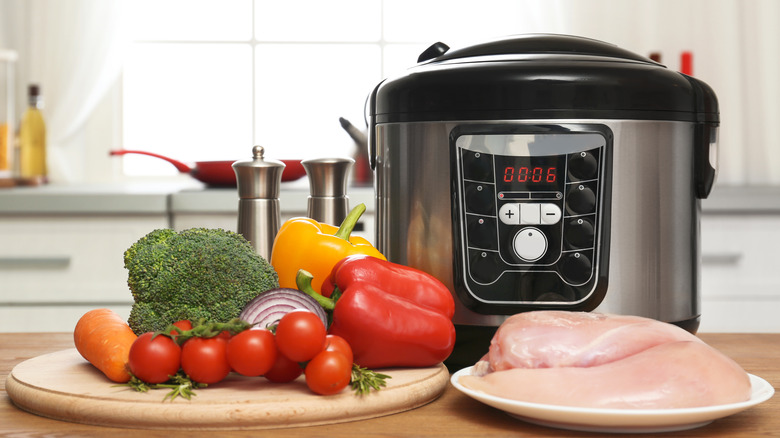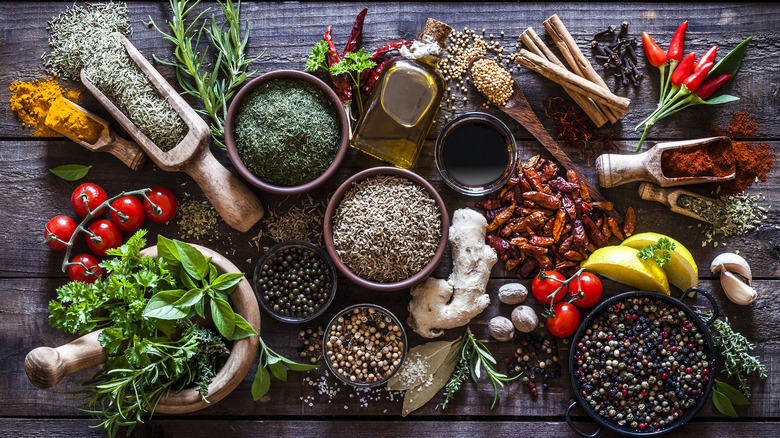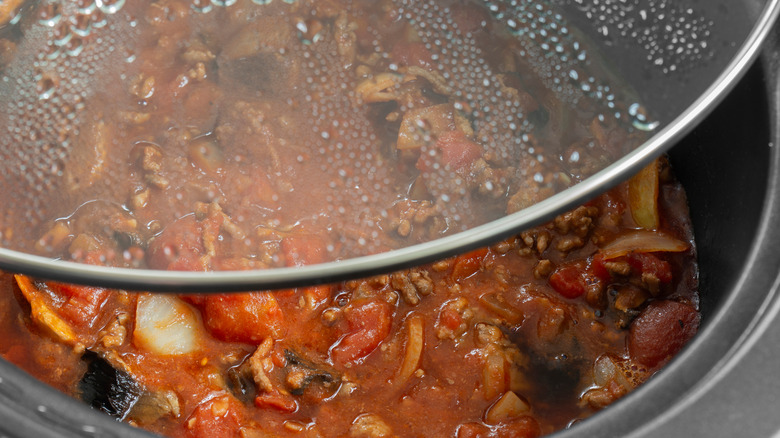What To Consider Before Making Your Own Slow Cooker Recipe
The appeal of a slow cooker meal is undeniable. The promise of a hot, homemade meal waiting for you is almost like having a personal chef available at your convenience. Recipes tailored for slow cookers have come a long way since the days of relying on canned creamed soup and being limited to casseroles. Nowadays, you'll discover all sorts of ideas, from sesame chicken to trendy beef birria for tacos, and even warm artichoke dip. Why not adapt some of your favorite dishes to the slow cooker yourself? It's a great idea, but when switching up a beloved family recipe so it can be cooked in the convenience of a slow cooker, it's crucial to consider a few points. Think about what the slow cooker excels at and what its limitations are before attempting to prepare that dinner.
Slow cookers are essentially braising devices, using low heat, time, and moisture to prepare foods, particularly those that require time to tenderize. As a result, dry beans become thoroughly hydrated and creamy, tough meat tendons break down into gelatin, delivering a delightful mouthfeel, and seasonings fully blossom and blend.
While slow cookers are incredibly convenient, they do have limitations. One drawback is the inability to fine-tune the heat. It's also important to refrain from frequently lifting the lid to add or remove ingredients during the cooking process, as this can lower the cooking temperature. Keep these considerations in mind to ensure your slow cooker dishes turn out as planned.
Think through what meats to use
When considering what meat to use for a slow cooker meal, the options are wonderfully diverse. Tough cuts like chuck roast, pork shoulder, or beef brisket are ideal candidates for the slow cooker, as the low, slow cooking process tenderizes them, turning them into succulent, melt-in-your-mouth creations. Chicken drumsticks or thighs work well for poultry dishes, soaking up the flavors of your chosen seasonings. You can also consider lamb shanks for a hearty, fall-off-the-bone meal. Leaner cuts like chicken breast or beef tenderloin don't fare well in the slow cooker due to their lack of tendons and internal fat content.
Ground meats such as beef or turkey or a pot of simmering sausages, combined with fresh vegetables and aromatic spices, also yield a delightful one-pot wonder.
Now, here's a crucial tip: Don't skip the browning step. While the slow cooker is excellent at tenderizing, it can't generate the high temperatures required for that caramelized Maillard reaction, which is responsible for creating rich, flavorful browning. Skipping this step might result in a less appetizing, lackluster appearance and taste, so don't forget to brown your meats separately first for the best results.
Get the liquid right
Liquid content plays a pivotal role in the outcome of dishes you're adapting for the slow cooker. Depending on the recipe, you might use broths, stocks, wine, or even just the moisture content of food to create the right cooking environment. It's important to be mindful of the quantity and type of liquid you add, as too much can lead to a watery result, while too little may result in a dish that's too dry. But don't forget that the slow cooker retains moisture exceptionally well, so you often need less liquid than in conventional cooking methods.
The lid of a slow cooker plays a pivotal role in retaining moisture and heat, enabling the consistent low heat to work its culinary magic. Opening it too often can reduce the heat, which slows cooking down and allows steam to escape. And because that tight-fitting lid needs to stay on, the liquid in a recipe will not evaporate as it might in a Dutch oven on the stove or in the oven.
Use care when adding ingredients
We like to think of slow cooker meals as "set it and forget it", but adding all of the ingredients in a recipe may not always work. To achieve well-balanced, flavorful results, it's crucial to consider the cooking times for different components. Generally, tougher ingredients, like root vegetables and meat, should go in first as they take longer to become tender. Next, layer in any grains or pasta and any seasonings or spices to allow them to infuse the dish. If your recipe contains more delicate ingredients such as dairy, fresh herbs, or leafy greens, they should be added during the last hour or so of cooking to prevent them from becoming overcooked or losing their vibrant flavors.
Think about the size of your cut ingredients as well. Small diced vegetables such as potatoes, carrots, or squash could disintegrate into mush after several hours. Larger chunks will hold up better.
Adjust your seasoning wisely
Seasonings are the secret ingredients that elevate all recipes from ordinary to extraordinary. Slow cooking allows flavors to meld and intensify over time, so if you are converting a favorite family recipe, you might need to adjust the spices and aromatics. Classics like garlic, onion, bay leaves, and thyme are great for adding depth to savory Mediterranean-style dishes, and with a long simmer in the slow cooker, they will become a background blend of flavors. Save any key flavoring for closer to the end of cooking so it will keep its character. Dry spices like cinnamon, nutmeg, and herbs can become quite potent, so consider cutting back a bit until you understand the impact.
Feel free to get creative with your choice of seasonings for your slow cooker recipes, but keep in mind that a little seasoning can go a long way. One key tip to remember is to add acidic ingredients like lemon juice or vinegar towards the end of the cooking process. This way, you'll preserve the vibrant, piquant flavors that might otherwise cook away if added too early.
A few recipe ideas you can adapt
Considering all these tips, it makes sense to start creating your own slow cooker recipes by considering the set of braised and simmered dishes. For example, Ina Garten's classic brisket recipe has a perfect cut of meat for the slow cooker — it's a tougher cut with plenty of internal marbling. The vegetables are kept in larger pieces, and the seasoning is sparse so that the beefy flavor comes through. Swapping out a Dutch oven for your slow cooker makes a meal you can't wait to come home for.
The slow cooker is perfect for converting dried beans into a creamy textured, tempting side dish or base for a protein bowl. Add a little more liquid and you'll get soupy beans, great for stirring in a handful of greens — even more liquid and you'll have bean soup. Swapping the stovetop for a slow cooker when making a pasta sauce, such as bolognese, or an Italian-American Sunday gravy means fewer sputtering splats of tomato to clean off the walls thanks to the lid. Why not try curry recipes in the slow cooker? Ones with plenty of sauce should work well. Or go for classic French dishes like boeuf bourguignon, so long as you brown the bacon and beef first. So, don't hesitate to experiment with your favorite ingredients, seasonings, and cooking times, and start curating your own signature slow cooker creations that will impress your taste buds and simplify your cooking routine.
